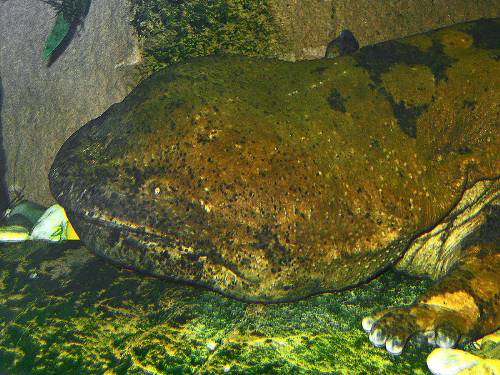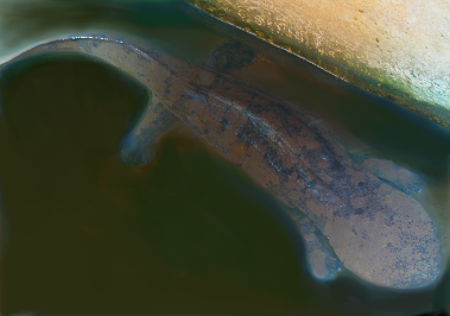Chinese Giant Salamander
Online Biology Dictionary
|
|
The Chinese Giant Salamander (Andrias davidianus) is the largest amphibian in the world.

|
|
Andrias davidianus Image: H. Zell |

|
| Andrias davidianus. Image: Namiac |
According to Ye et al. (1993), it can reach a maximum length of 195 cm (6.39 ft) in females and 184 cm (6.04 ft) in males. A very large individual may weigh as much as 70 kg (154 lbs) (Murphy et al. 2000), but most specimens are smaller (Liu and Liu 1998). They continue growing throughout life and may reach an age of 80 years or more.
These giants live in rocky upland streams and lakes with clear, well-oxygenated water. They are usually only nocturnally active, retiring to their burrows by day. Because adults lack gills, they periodically lift their nostrils above the surface to breath.
During breeding season the male aggressively guards his burrow, but allows females to enter and spawn there. He then fertilizes the eggs and guards them till they hatch, which takes 50-60 days.
Geographic Range: China, from Qinghai to Jiangsu and south to Sichuan, Guanxi and Guangdong; also introduced in Taiwan.
IUCN Status: Critically endangered.
About Japanese Giant Salamanders >>
Original description: Andrias davidianus was first described by the French zoologist Émile Blanchard (1871).
Etymology: The generic name, Andrias, derives from the fact that this tremendous amphibian can be as large as a human being (andros is Greek for man). Its namer Émile Blanchard gave it its specific name in honor of the French missionary Fr. Jean Pierre Armand David (Père David) (1826–1900).
Synonym: Sieboldia davidiana.
Order Urodela (Salamanders): Salamanders are amphibians with a lizard-like appearance. Unlike frogs, they have a tail in both the larval and adult stages of their life cycle.
Works cited:
Liu, G., and Q. Liu 1998. Andrias davidianus (Blanchard, 1871). In: China Red Data Book of Endangered Animals. Amphibia and Reptilia., (ed.) Zhao, E., pp. 30-33. China: Science Press, Beijing.
Blanchard, É. 1871. Note sur une nouvelle salamandre gigantesque (Sieboldia davidiana Blanch.) de la China occidentale. Comptes Rendus hebdomadaires des séances de l'Académie des Sciences, 73:79–80.
Murphy, R.W. et al. 2000. Genetic variability among endangered Chinese giant salamanders, Andrias davidianus. Molecular Ecology 9, pp. 1539–1547.
Ye, C.-Y, Fei, L., Hu, S.Q. 1993. Rare and Economic Amphibians of China. Chengdu: Sichuan Publishing House of Science and Technology.
Most shared on Macroevolution.net:
Human Origins: Are we hybrids?
On the Origins of New Forms of Life
Mammalian Hybrids
Cat-rabbit Hybrids: Fact or fiction?
Famous Biologists
Dog-cow Hybrids
Georges Cuvier: A Biography
Prothero: A Rebuttal
Branches of Biology
Dog-fox Hybrids